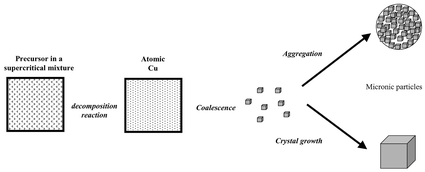Abstract
The purpose of this work is to take advantage of specific properties of supercritical media to develop a new route for elaboration of fine metal powders. The process consists of the thermal decomposition of a copper precursor previously solubilized in a CO2/
It has been shown that low initial concentrations of precursor lead to spherical homogeneous nanostructurated particles with a mean size down to below 1 µm, well crystallized, and free from
The mechanism of particle growth in supercritical media has been examined assuming both total and partial coalescence (aggregation), since those mechanisms dominate the particle synthesis, according to experimental and simulation results.


 Please wait while we load your content...
Please wait while we load your content...